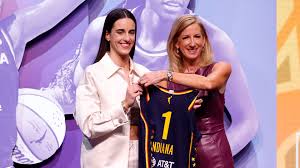Commentator Jason Whitlock called their salaries, which are said to be in the neighborhood of $75,000 a year, “overpaid.” This statement sparked a controversy. The topic of player remuneration has become a contentious issue with WNBA stars Caitlin Clark and Angel Reese, who were both recently chosen into the professional league.
Notoriety for his thought-provoking remarks, Whitlock maintained that the young players haven’t shown enough to merit these kinds of compensation. He also suggested that they should put more emphasis on playing and not follow the activist path of WNBA veteran and vocal social activist Megan Rapinoe.
Whitlock’s remarks about WNBA salary have been met with criticism for their condescending tone and lack of background, but they have also rekindled an important discussion about athlete pay and gender inequality in professional sports.
Won’t Pay Like That in the NBAIt’s critical to comprehend the WNBA’s financial structure when assessing player compensation. The WNBA’s revenue stream is far smaller than that of the NBA. For WNBA players, this difference means a lower wage pool. Compared to the multi-million dollar contracts that are typical in the NBA, the average wage in the WNBA is allegedly approximately $120,000.
To put things in perspective, NBA rookies can start with beginning salaries of more than $4 million per year. Both Clark and Reese were highly decorated NCAA athletes with sizable fan bases and the potential to improve league viewing, even if they may not be considered established veterans.
Beyond the Stats: Establishing the WNBA
There is more to this discussion about WNBA pay than just basic economics. Long-term league growth depends on making investments in young players like Clark and Reese. These athletes could go on to become famous in the future, drawing greater attention from sponsors and supporters. All WNBA players stand to gain in the long run from their marketability, which can increase the share of revenue.
Whitlock also minimizes the important role WNBA players have had in promoting social justice concerns by discounting their advocacy. Using her platform to raise awareness of significant topics, Rapinoe, for instance, has been a strong advocate for racial equality and LGBTQ+ rights. These initiatives have drawn in a more socially conscious fan base and shaped the WNBA’s public perception.
Are We Going to See Parity Soon?
The discussion about WNBA pay reflects the continuous struggle in sports for parity between genders. The difference between professional sports leagues for men and women is still quite large, despite recent major progress.
Closing this gap is a continuous effort. An innovative eight-year collective bargaining agreement, which includes better travel conditions, pay raises, and maternity leave benefits, was just inked by the WNBA. A lot more work remains, even though this is a wonderful step.
The Path Forward
Because of their skills, commitment, and positive influence on the sport, WNBA players ought to be appreciated. Despite the league’s financial difficulties, Whitlock’s remarks don’t really advance the discussion. A sustainable future where WNBA players are respected for their actual worth will instead be made possible by concentrating on expanding the league’s fan base, luring sponsorships, and fighting for equitable pay.
The WNBA’s forthcoming season will be very important. Bringing in viewers and money will be greatly influenced by the success of Clark, Reese, and other up-and-coming talent. It’s also a chance to highlight the skill and commitment of WNBA players, which should pave the way for a time when discussions about their worth center on their accomplishments rather than antiquated ideas of overpayment.





